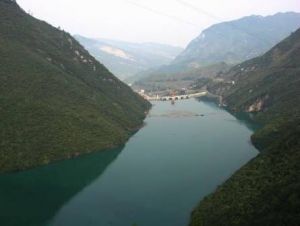Furong River
The Furong River, called the Pangu River in ancient times, originates in the Dalou Mountains in Guizhou, and runs south to north into the Wujiang River at Wulong County, Chongqing, with a total length 243 km. It is the largest tributary of the Wujiang River. The section within Wulong County is 35 km long. It is given the name "Furong" (Lotus) due to profuse lotuses along the banks.
The banks of the Furong River have a dense vegetation cover. Subtropical secondary forests cover the banks and rare species of animals and birds can be found there. The 20-30-m-high roots of old trees on the cliffs have grown thickly interwoven into a net, projecting onto the river like so many snakes trying to drink the water. The riverside areas boast quite a few key nationally protected tree species, such as Cathay silver fir, ginkgo, yew, Henry Emmenopterys, and sassafras. They are an ideal habitat for clouded leopard, tufted deer, forest musk deer, Francois’ leaf monkey, zibet, large and small Indian civet, white monkey, Temminck’s tragopan and Reeves’ pheasant. Wild ducks, mandarin ducks and white cranes may be seen on the islets in the river. Golden eagles and rock eagles migrate over the gorge.
In addition, the Furong River Scenic Area has over 500 limestone caves, among which Furong Cave is the most renowned. Originally called the “Qi Cave,” it is a giant elongated limestone cave, known as the “No. 1 Cave on Earth” for its extraordinary scientific and tourist value. It, together with the Mammoth Cave in the US and the Clamouse Cave in France, have been acclaimed as the three greatest caves of the world.
